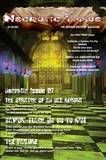Necrotic Tissue (Issue 7) / Edited by R. Scott McCoy
 Stygian Publishing / July 2009
Stygian Publishing / July 2009
Reviewed by: Rich Ristow
Genre publishing is filled with start-up-failures. One sees this all the time on high-traffic message boards. A would-be editor starts a thread, proclaiming their brand spanking new periodical will change the face of horror, that they’re the new wave, that they’re up and coming, that the “mainstream” is keeping down aspiring writers, that the “five cents a word payment” is a tyranny mandated by the HWA, that they’re only going to pay half a penny per word, and so on. Meanwhile, the product they’re offering is usually passé and unoriginal. The stories themselves have editing problems and strike a potential reader as retreads and poor imitations of more successful writers. The problem with these magazines and editors is simple: They started with wholly unrealistic promises and expectations, and publically, they have no other place to go, other than to exit stage right with egg on their face.
Of course, there is no set way to build a successful publishing venture. Different people find different ways and methods that work for them. There, is, however, one generally shared tactic. For example, there’s the recent edition of R. Scott McCoy’s journal Necrotic Tissue. McCoy follows the “start small and slowly build model” that has worked for some. Necrotic Tissue began as an online PDF magazine, where issues were free to download. As of their July issue, they’ve changed to a printed, trade paperback format. Their schedule promises quarterly issues. But, a change in format is not the sole niche-carving tactic R. Scott McCoy has employed. The journal has sought to build its own identity.
First, there’s not a lot of non-fiction. Most periodicals have a review section; Necrotic Tissue doesn’t. There are no essays on the latest novels, no reviews of theatrical of direct-to-DVD horror films. There are no commentaries on the publishing industry, or even fact-filled columns on the history of horror in culture. There are only a handful of editorials, some of which cover writing, and some of which take care of “editorial house cleaning.” One gets the impression that they’re in the pages more for clarification than anything else. That’s fine, and in fact, it’s in keeping with R. Scott McCoy’s direction.
Necrotic Tissue employs a tagline on its cover: “The Horror Writers Magazine.” That could imply a couple of things. First, it’s about craft of writing horror fiction, but the lack of essays instantly dispels that notion. So, one is left with the alternate interpretation, one McCoy likely intended: Necrotic Tissue is meant as a venue for horror writers to showcase their work. The lack of reviews, in this regard, strips down the focus to a more singular vision. By not publishing essays and reviews, Necrotic Tissue has more space for fiction.
The stories are split by two separate aesthetics. There’s traditional horror, as evidenced by Horace James’s “El Dorado” – the dead come back to life in the form of reanimated skeletons, bent on revenge. Most of the stories also cater to a character-centered narrative approach. “Less of a Man,” by Mark Leslie, deals with an anguished son; the son will do anything to see a healthy pallor return to his cancer- ridden father, he’d willingly sacrifice a few fingers. These two examples represent one end of the spectrum; the magazine also publishes something akin to prose poetry.
R. Scott McCoy solicits and accepts 100-word stories. These fiction nibbles, due to the imposed word count, sometimes forgo a perfect sense of narrative in favor of “the lyric moment” one often finds in poetry. Necrotic Tissue’s July 2009 issue features seven of these works. J.B Daniels offers a piece about a skeletal throne, where the nature of its composition functions as a sort of dreadful epiphany. Mathew Ewald employs strike-through text, as a way to give a variation off of a few sentences from Bram Stoker’s Dracula. Generally, these works are concise and tightly composed.
Admittedly, most of the stories here – whether traditional or told in 100-words – will not be gracing a yearly best-of genre retrospective. They are fun, however, and a reader will likely leave the July issue of Necrotic Tissue with a good sense of anticipation. As mentioned earlier, publishing is filled with mediocre journals that start with publically stated delusions of grandeur, only to implode. Necrotic Tissue is clearly not one of those types. It’s going to be interesting to watch this particular journal grow.
Purchase the July 2009 issue of Necrotic Tissue, edited by R. Scott McCoy.



